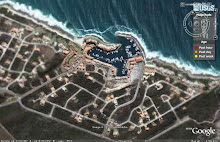
Why is man so slow to learn? Mess with Nature, and she bites back. We have featured the fascinating
sand river before, and mentioned that the road is frequently bulldozed to keep the dune from encroaching over it. When the road was built it was basically just put across the sand river, with small pipes to allow for the river to flow under it. Because, for much of the year, it is a subterranean river system, with minimal flow, this seemed like a good idea at the time.
However, dunes migrate, and rivers flood. And natural wetlands act as giant sponges which absorb much of the water which causes flooding, thus reducing the impact. And when you mess with any of these, you will cause problems. The vlei (wetland area) adjoining the sand river system has been turned into a golf course. And in recent years the sand river has come down in flood more frequently, dumping vast quantities of the dune sand on the lower lying properties across the road.
This is all that can be seen of the very large bulldozer which used to be kept on site for regular dune clearing on the road.... after the flood of August 2006. 2007 was an unusually wet year, and the river flooded again in March and December. At some point a plan will have to be made to channel it more effectively and re-make the road so that it does not cause so much damage, but that may be a while. Judging by the state of all the roads in the area (pothole dodging could become a popular local sport) fixing the infrastructure seems to be low on the list of priorities for the local council.





























